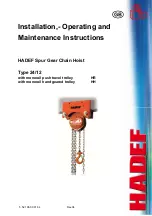
P
RODUCT INFORMATION
Temperature limits for explosion-hazardous
dusts
In areas that are potentially explosive
due to combustible dusts, the surface temperature
must not exceed two-thirds of the ignition temper-
ature in
◦
C of the dust/air mixture. The tempera-
tures of surfaces on which hazardous deposits of
combustible dusts can be formed must not exceed
the glow temperature of the relevant dust that is
reduced by 75K. Greater safety margins are re-
quired if the thickness of the dust layer exceeds 5
mm.
The corresponding surface temperatures can
be derived from the lowest values for glow and
ignition temperatures of dusts specified in the
HVBG/BIA report 12/97 “Combustion and explo-
sion characteristics of dusts”.
Examples:
Synthetic rubber, soot-containing:
Glow temperature 220
◦
C - 75
◦
C = 145
◦
C max.
permissible surface temperature
Stearic acid:
Ignition temperature 190
◦
C x 2/3 =126
◦
C max.
permissible surface temperature
For further information:
6
Guideline 94/9/EC of the European Parliament and the
Council dated 23 March 1994 on the adaptation of the laws
of the Member States concerning equipment and protective
systems intended for use in potentially explosive atmo-
spheres
7
DIN EN 1127-1: Explosive atmospheres - Explosion preven-
tion and protection - Part 1: Basic concepts and methodol-
ogy, 1997-10
8
EN 13463-1: Non-electrical devices intended for use in
explosive areas - Part 1: Basic methodology and require-
ments, 07/2009
3.11.
CE
-marking
Your product
PROFI 16 TI
is marked with
CE
. In
the delivered design, your product meets all rele-
vant provisions of the EC directive for which you
have received a declaration of conformity.
For more information:
,
→
EC declaration of conformity
3.12. Spare parts
Only use
original JDN spare parts
. J.D. Neuhaus
GmbH & Co. KG accepts no liability for the use of
non-original components and / or modifications by
unauthorised persons.
Page
26
of 64
Doc.-No.: VA049318-20-OM-EN-0319-64-6





































